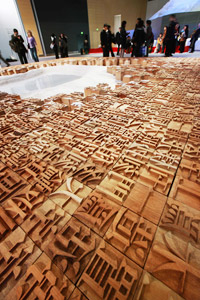|
 |
|
Visitors appreciate the 40-meter-long "paper," known as "Book Mountain," at the Frankfurt Book Fair's China Pavilion (XINHUA) |
Li Jiwei, chief designer of the China Pavilion at the Frankfurt Book Fair, based his design on four elements that are key to Chinese culture: paper, ink, books and Chinese characters.
"The China Pavilion's design, focusing on the themes of tradition and innovation, aims to create an artistic space that showcases the kernels of Chinese culture," said Li.
A 40-meter-long "paper," known as "Book Mountain," rises into the air. Composed of several thousand pieces of xuanzhi (rice paper good for traditional Chinese paintings and calligraphy), it consumes 60 tons of boccaro (reddish-brownish) mud and 30 tons of plaster, as well as glass-fiber reinforced plastics.
The mountain, totaling more than 300 square meters, represents the great contribution of paper, one of China's four great inventions, to mankind in the past and today.
More than 1,000 tremendous moveable Chinese characters, in the shape of a phalanx, are located in the center of the pavilion. In the middle of the phalanx stands a small white pond with waving water representing a drop of Chinese ink, one of the four treasures of Chinese stationery (the other three being the writing brush, paper and the inkstone). Chinese ink, representing the progressive spirit of Chinese intellectuals, has close relations with paper and calligraphy.
Some 10,000 volumes of books create a "Long River of Reading," unfolding the evolution of Chinese handwriting from oracle bones to calligraphy. Green plants and foldouts are mixed up with page layouts, creating a sense of humanism and environmental protection.
Various exhibitions presenting the evolution and development of Chinese culture are also on display at the China Pavilion in different themed sections. They include early Chinese characters, papermaking, printing, modern publications and public literature.
 |
|
More than 1,000 tremendous moveable Chinese characters, in the shape of a phalanx, are located in the center of the China Pavilion at Frankfurt Book Fair (XINHUA) | When starting the design, Li constantly asked himself how to embody China's 5,000-year history in such a limited space. "Using the most typical Chinese cultural elements helped make the design more artistic," Li told Beijing Review.
Li also worried whether his works would be understood. "Chinese intellectuals have great differences with Westerners in terms of artistic appreciation," he said. "It may hard for the latter to understand images such as a painting imbedded in a poem, or a poem in a painting, which are artistic conceptions of the Chinese people.
"But all new artistic works entail risk, and there would be no creation without risk," said Li, who has spent more than 20 years abroad in countries including the United States, Austria and Germany.
"This design is a departure from the traditional exhibition method," said Song Xiewei, a professor at the China Central Academy of Fine Arts. "It emphasizes mainly an artistic conception of Chinese culture.
"Focusing on the four cultural elements of China, Li presents their logical relations," said Song. "Employing modern arts and means, the 'white paper' produces a strong visual impact, helping visitors engage with Chinese culture in an easy, direct way.
"To sum up, the design showcases Chinese cultural potential and Chinese arts on the basis of traditional Chinese culture," said Song.
"It's a great exhibition," said a German journalist named Peter, who lived in China for six months this year, "especially the paper, which enables people to think about amalgamation and communication."
(Reporting from Frankfurt, Germany) |
